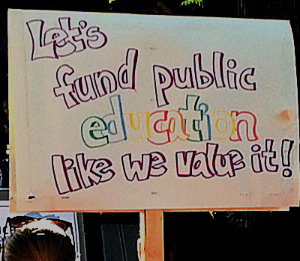The following guest post was written by Amy McKeever, a Pontiac School District teacher and the President of the Pontiac Education Association.
Enjoy.
 While much attention has been focused on the horrendous condition of Detroit Public School buildings, the health and safety concerns are no less dire in the Pontiac School District, where the majority of buildings are over 50 years old.
While much attention has been focused on the horrendous condition of Detroit Public School buildings, the health and safety concerns are no less dire in the Pontiac School District, where the majority of buildings are over 50 years old.
On March 8, voters in the Pontiac School District can do something about it — they can vote “Yes” on the Building and Site Sinking Fund millage to provide funding for much needed building repairs, at a cost to the average Pontiac homeowner of less than 40 cents a day — less than forty cents a day to repair buckling floors, water damaged walls and leaking roofs — less than forty cents a day to fix malfunctioning boilers, control erratic classroom temperatures and repair ventilation systems. Small change for big changes.
A second issue on the March 8 ballot is a renewal of the non-homestead millage. This renewal will not increase taxes and does not apply to homeowners. It is simply a reauthorization of an existing millage which will fund the most basic classroom needs such as books, technology and staffing. It is crucial to meet those classroom needs.
However, the best textbooks, technology and teachers in the world won’t be effective if students are trying to learn in unsafe buildings.
As President of the Pontiac Education Association, I am in Pontiac school buildings every day, teaching and providing representation to the 250 plus teachers I serve in the Pontiac School District. I am on the front lines of the fight to provide a safe and healthy learning environment for Pontiac students, and I need your help.
As a teacher in Pontiac, I understand tight budgets. Pontiac school employees have made great sacrifices to keep Pontiac schools open. Wages have been slashed and benefit costs have been dramatically reduced as teachers pay more out of pocket costs to keep the district afloat. And those sacrifices are working as we have helped reduce the budget deficit by 33 percent in just two years. Pontiac school employees have made these sacrifices under threat of having our school district taken over by an emergency manager. That approach has failed spectacularly in other cities and school districts across the state. We will continue to fight to find ways to make ends meet, so that we do not face a state takeover and an emergency manager from outside our community making decisions about our kids and our schools.
But Pontiac residents have a part to play as well. As you make your decision over how to vote on the two ballot proposals for our schools, you should ask yourself a few questions:
- How much is it worth to provide a quality education in a building that is safe?
- How much is it worth to provide enough teachers so class sizes are manageable?
- How much is it worth to provide enough books and technology so our kids can compete for jobs and admission to college?
Last May, the sinking fund millage was defeated by 116 votes out of nearly 5,400 votes cast. Pontiac voters approved the millage by a nearly two-to-one margin, but voters in communities outside Pontiac overwhelmingly rejected the sinking fund millage. To voters in those communities, I make a special plea: Please consider the learning conditions of Pontiac students when you make your decision on these proposals. Schools are the backbone of our cities. When school buildings deteriorate, the entire metropolitan area suffers. While it may be tempting to view this as just a “Pontiac problem,” in reality, unsafe conditions in Pontiac schools negatively affects the entire region.
On March 8, I urge you to vote “Yes” to provide safe learning conditions for Pontiac students.



